|
UNDER THE RADAR: WEB DETECTIVE STORIES
by Peter Enfantino He hit the girl so hard in the gut the
sound was enough to make you sick. Squishy, like when you squeeze
a sponge. I thought she’d upchuck everything she’d ate for a week.
– from “As Hot as Ginger” by Art Crockett (Web Detective, Vol. 3 No. 3, Oct 1960) To find class in 1950s crime digests, look no further than Manhunt. To find something a little more unorthodox, a little sleazier, a little goofier, hunt down Web Detective Stories. It won’t be easy, but the spoils are worth the hassle. Of all the crime digests I’ve collected, the one title that gave me the most trouble was WDS. It’s not just that WDS suffered from lousy distribution and rack placement (as did most of the lesser crime digests of the early 1960s), but it also has the distinction of being one of the most confusing digests of all time. WDS was born Saturn, The Magazine of Science Fiction (Candar Publishing) in March 1957. The editor was the respected Donald A. Wollheim, editor of Ace Books (later to found DAW Books), and the contents varied from non-fiction to reprints to fiction by such genre mainstays as Harlan Ellison and Robert Silverberg. Not able to distinguish itself from the dozens of other SF digests of the Day, Saturn soon found itself facing extinction. For some unknown reason, the publisher chose to simply change its title to Saturn Web Detective Stories after only five issues, rather than kill Saturn SF and start up a crime digest. (I’m assuming that the publisher, in his infinite wisdom, decided that the crime waters weren’t as crowded as the SF sea.) The Saturn was dropped after four issues and the title became simply Web Detective. This title-changing contributes to some of the mass confusion surrounding WDS. If it weren’t for crime scholars and historians like Bill Pronzini and Mike Ashley, today’s collectors would still be searching the back rooms of old bookstores (not too likely) or the cyberspace of eBay (very likely) for information regarding those mysterious first five issues of WDS. Add to the confusion the fact that there are actually two issues labeled Volume Two, Number Three, and that some of the issues are dated differently on their covers and contents page (presenting dealers with the dilemma:which date do I list in my catalogue?), and you can understand why this run is such a collecting nightmare. I told her who I was and what I
wanted. I also gave her a smile, half power. What I could
see above the typewriter looked usable. It couldn’t be all
hers. But, what the hell, I’ve got padded shoulders in my jacket,
so we’re even.
– from “Just Kill Him, Darling” by Jay Richards (WDS, Vol. 2 No. 3, April 1959) So I’ve told you the how, but now you want to know the why. Why should the discerning crime digest collector spend maybe twenty to thirty bucks an issue for WDS? If you are the typical crazed collector, chances are WDS is on your want list anyway. So, fine, you’ve got them on the list. Should you just put them in a sleeve and adore their garish covers or are they worth reading? I think so, but not many others side with me on my opinion since I’ve yet to see a WDS story anthologized, even though there are at least two dozen (out of 148 stories) that are worthy of a second look. Lawrence Block, Harlan Ellison, Edward D. Hoch, Ed Lacy, H. A. DeRosso, Frank Kane, Robert Silverberg, Henry Slesar, Fletcher Flora. Does this sound like the lineup of a worthless venture? You don’t care about the insides? You want GGA? You got it. WDS delivers in spades with lurid, pulpish, colorful covers reminiscent of such pulp titles as Dime Mystery and Horror Stories. Big-breasted women threatened with knives or heaters. The titles of many of the stories also evoked memories of the pulp days: “Scream the Night Through,” “Short Cut to Hell,” “Murder Wins the Jackpot,” “Dumb Blondes are Murder.” After fourteen issues, the publisher once again decided that a genre change was in order, so Web Detective Stories became Web Terror Stories and featured horror stories with an s/m and bondage slant. A 1960s version of the Spicy line of pulps. In all, there were fourteen issues of (Saturn) Web Detective Stories. Every one of them has something to recommend it. Here are some highlights, with at least one per issue: 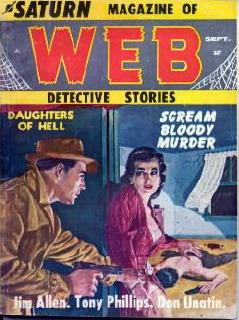 Vol. 1 No. 6 (August 1958- September on cover) “Rumble Bait” by Jimmy L. Carroll Cal Johnson’s life has never been the same since he turned squealer on his partner. Now he’s opened himself up for beatings on the street from everyone, including our man of the moment, Slim. Our story opens with Slim doing the squealer stomp on poor Cal on his way to meet up with parter-in-crime, Fats. The two are caught by a shotgun-wielding farmer while stealing watermelons. Fats gets away but Slim goes right to jail without passing GO. To avoid severe beatings from the sheriff and his sadistic deputy, Slim gives up Fats on the condition that no one on the street is to find out exactly who gave up Fats. But the sheriff isn’t known for his honesty, and Slim becomes “open game” on the streets just like his old friend Cal. Reminded me a lot of EC Shock Suspenstories comics, which populated itself with corrupt lawmen and ironic comeuppances. Vol. 2 No. 1 (October 1958) “A Touch of Evil” by Jim Allen Card shark Johnny Morgan rolls into town and joins in a game with the respectable, and quite wealthy, Lou Shero. Morgan takes Shero for every penny he’s worth, which doesn’t sit well with the big man. Morgan is set up as fall guy for a rape charge by one of Shero’s working girls and is hauled away by the cops. A jawdropper is that the working girl is actually Shero’s daughter! Vol. 2 No. 2 (February 1959) “Sure Bet on Death!” by Buck Grimes Boxing manager Sandy Michaels spots the surest thing he’s ever laid eyes on: Mugsy Thomas. With no money, Michaels has to go to loan shark Whitie Malone for the bucks to train Mugsy. In the meantime, Mugsy falls for Greta, a (big surprise here) busty, curvy knockout. The bimbo lures the fighter away from Sandy with promises of lust-filled nights and diamond-studded dog collars. All the walls seem to be coming down on Sandy Michaels at the same time and the nice guy is definitely finishing last. A really good sports/mob thriller that’s about as close to a short Gold Medal novel as you’re likely to find in the pages of WDS. Vol. 2 No. 3 (April 1959) “Mark Him for Me!” by Jim Barnett A violent gang with the moniker of The Pythons moves into town and immediately starts to shake everything up and everyone down. A rival gang, newly crowned The Mongooses, decides to do something about it. Good juvenile delinquent tale with a nice surprise climax. This issue also features an early story by Lawrence Block. Vol. 2 No. 3 (June 1959) “Hate Goes Courting” by Lawrence Block Very short and very stark, “Hate Goes Courting!” tells the story of two brothers, John and Brad, and John’s fiance Margie, a girl with a questionable past. Brad knows about that past and continually taunts his brother until the man finally bursts out in rage: When you’re up close a shotgun makes a big
messy hole, big as a man’s fist, but when I squeezed that trigger the
shell went through him like a sword through a piece of silk, like the
wind blowing outside. He let out a moan and sat down
slowly. His eyes were staring like he couldn’t believe it
happened.
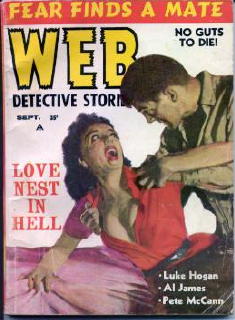 Vol. 2 No. 4 (September 1959) “Murder Flashes Dark Eyes” by Grover Brinkman Ollie and Clint pull off a bank heist, but it gets messy and two end up dead. They hightail it over the river into Mexico, only to find themselves wanted by scavengers more deadly than the police. Excellent tale ends dark when Ollie’s back is to the wall and there’s only one way out. This issue also features an above-average revenge tale by Robert Silverberg. 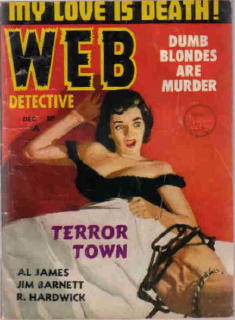 Vol. 2 No. 5 (December 1959) “Terror Town” by Art Crockett After a steamy rendezvous, Rod Baxter learns to his chagrin that the town vixen is actually an “innocent teen.” To add to his troubles, the townfolk don’t cotton to their innocents being deflowered by total strangers, and they drag Rod out to the woods to string him up. Good twist at the conclusion as we learn that the town might just suspect the truth after all. 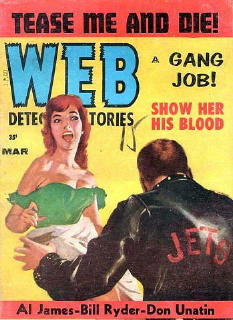 Vol. 2 No. 6 (February 1960- March on cover) “Gang Job” by Zack Steele A beat cop has to bring in a retarded boy who has been tricked into murdering his own brother by a street gang. Not the usual JD story, “Gang Job” focuses on the damage the gang leaves in its wake rather than the sensationalistic aspects inherent in most JD stories. In fact, the gang itself is never actually featured in the story. “Gang Job” brings to mind the best 1950s youth crime fiction written by Ed McBain. 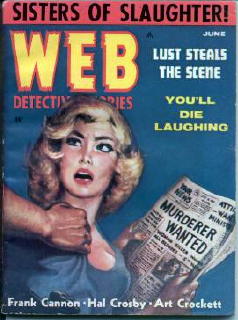 Vol. 3 No. 1 (May 1960- June on cover) “You’ll Die Laughing” by Jack Kavanaugh Artie has a falling out with his mob boss Christy over, what else, a dame, and becomes target practice for the mobster’s gang. Wounded both mentally and physically, Artie decides to confront and mow down the big man before he himself becomes part of the sidewalk. Strictly average crime short until the closing paragraphs which find the crazed Artie at last face to face with the boss man. Vol. 3 No. 2 (August 1960) “Murder is Eternal” by Edward D. Hoch Our unnamed narrator accepts the job of assassinating “The Eternal Brother,” a cult leader who’s amassed a fortune for himself from a legion of gullible believers. The job goes awry and the gunman finds himself on the run. Frustrating and fascinating. This is a good example of why Ed Hoch has remained a force in the mystery short story field for fifty years. Through his several revolving series (supernatural sleuth Simon Ark, police Captain Leopold, nineteenth-century gunman Ben Snow, super thief Nick Velvet, and country doctor Dr. Sam Hawthorne), Hoch has had nearly one thousand stories published, including an unbroken string of appearances in Ellery Queen since May 1973. This issue also features a Johnny Liddell story by Frank Kane Vol. 3 No. 3 (October 1960) “The Triple Cross” by Richard Deming Private Investigator Manville Moon is hired by wealthy socialite Henry Sheffield, who’s convinced he’s being stalked by mobster Eddie Dallas. A solid PI mystery with a compelling character in Manville Moon, a card-carrying member of the so-called “Defective Detectives,” sleuths who suffer from some form of handicap, but who still save the day. Moon maintains a sense of humor despite the absence of a right leg – at one point in the story, his client checks Moon’s credentials while gazing at Moon’s artificial leg. Moon was also the star of three novels by Deming, The Gallows in My Garden (1953), Tweak the Devil’s Nose (1953) and Whistle Past the Graveyard (1954), as well as several short story appearances (in digests such as Manhunt). Deming is perhaps best known by paperback collectors as the author of several Dragnet and The Mod Squad TV tie-ins. 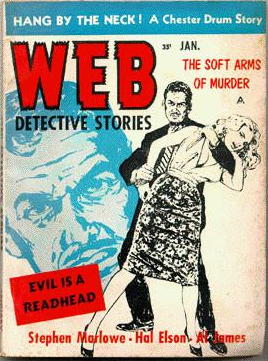 Vol. 3 No.
4 (January 1961) Vol. 3 No.
4 (January 1961)“Harness Bull” by Don Unatin Officer John Stewart reflects on his life as an honest cop and how that honesty has kept him at odds with the other cops in his precinct, all graft-takers. “Harness Bull” is almost like two short stories: one, the main plot, deals with Stewart’s endeavors to put away a mob boss who has gotten away with murder. The more interesting piece of the story though is its question of whether Stewart should have gone along with his fellow bulls in their crimes (and live the good life overflowing with money, women, and friends) or stay the straight course and keep a clean soul (and suffer the scorn of his colleagues, wife, and worse, dealing with his own self doubts). In the end, Stewart contemplates just that as he stumbles across a dead man with a load of cash. The author wisely ends his narrative right there before filling in the blanks and, instead, puts the question to the reader – “What would you do?” This issue also features a Chester Drum story by Stephen Marlowe and a great little character study by Ed Lacy. Vol. 3 No. 5 (May 1961) “Murder’s No Bargain” by James Holding Assassin Manuel Andradas, aka “The Photographer,” is hired by the Italian mafia to take out Giovanni Corelli, a well-known and wealthy building contractor who has been using faulty materials for his structures. Believing he has been underpaid for his services, The Photographer approaches Corelli with a deal: Corelli pays the hitman and he’ll smuggle him out of the country. When the contractor ponies up, the assassin does his job (in a particularly nasty way). James Holding wrote hundreds of short stories for the crime digests, including several more adventures of The Photographer for EQMM. A humorous aspect of the stories is that the hitman always haggles over the price his bosses are willing to pay him, feeling he’s always worth more. This issue (which I consider to be the most consistent issue of WDS) also features excellent stories by Hal Ellson, Jim Arthur, Ed Lacy, H. A. DeRosso, and Edward D. Hoch. You’ll also find another Johnny Liddell case by Frank Kane. If you buy only one issue of WDS, it should be this one. Vol. 3 No. 6 (September 1961) “Angel of Evil” by Robert Rossner Sandy, Mitch, David, and Kevin are staunch members of the “He-Man Women-Haters Club,” living together, partying together, vacationing together, until Mitch falls for the lovely Leora. At first, the other three men find her charming, but eventually the false charm erodes away and what stands before them is the angel of emasculation. The three men decide the best thing to do is kill Leora. So they do. Rossner does a good job of showing both dark and bright sides to each character. These three men only want what’s best for their fallen comrade and that justifies any action they might take. The matter-of-fact conversation wherein the trio plots Leora’s death evokes memories of the famous (and very similar) scene in Paddy Chayefsky’s Network. Another high quality WDS issue also features James Stevens’ well-written JD story, “Requiem for a Junkie,” and a typically above-average crime story by Harlan Ellison, “A Corpse Can Hate” (great story, lousy title). NOTE: This
article was first written for The
Pulp Crime Digests, edited by Gary Lovisi (Gryphon Books,
trade
pb, 2004) and appears here in slightly different form.
YOUR COMMENTS ARE WELCOME. Copyright © 2004,
2006 by Peter Enfantino.
|